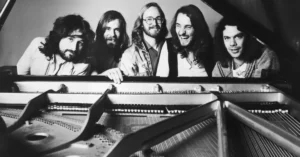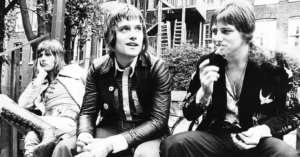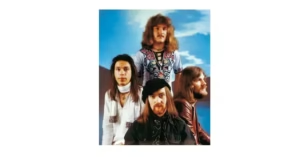Soft Machine: Architects of the Canterbury Sound and Psychedelic Jazz-Rock
Soft Machine. The Genesis of a Movement: Formation and Early Years
Soft Machine emerged in 1966 in Canterbury, England, a city that would become synonymous with an entire subgenre of progressive rock known as the Canterbury Scene. The original lineup featured:
- Robert Wyatt – drums and vocals
- Mike Ratledge – keyboards
- Kevin Ayers – bass and vocals
- Daevid Allen – guitar
Initially associated with the burgeoning British psychedelic underground, the band shared stages and ideas with groups like Pink Floyd and The Jimi Hendrix Experience (even touring with Hendrix in 1968).
But unlike their peers, Soft Machine didn’t settle into rock conventions. Their musical journey took them through surreal poetry, free-form jazz, Dadaist performance, and avant-garde minimalism—reshaping rock from the inside out.
The Psychedelic Phase: The Soft Machine (1968)
The band’s debut album, The Soft Machine (1968), is a swirling fusion of psychedelia, surrealism, and proto-prog experimentation. It balances Kevin Ayers’ baritone voice with Robert Wyatt’s whimsical vocals and jazzy drumming, all wrapped in Mike Ratledge’s fuzz organ madness.
Key tracks include:
- “Hope for Happiness” – Merges groove with dissonance.
- “Why Am I So Short?” – A brief, jazzy introspection.
- “We Did It Again” – A minimalist, hypnotic chant that prefigures krautrock.
Though critically praised, the album’s commercial impact was modest. Internal tensions led to the departure of Kevin Ayers, while Daevid Allen was barred re-entry into the UK and later formed Gong—a Canterbury pillar in its own right.
Towards Jazz Fusion: Volume Two and Third (1969–1970)
Soft Machine’s second album, Volume Two (1969), saw Wyatt and Ratledge embrace jazz complexity and conceptual suites. It also introduced Hugh Hopper on bass—a player who brought a grittier, more experimental tone.
Then came the landmark double album Third (1970)—a defining moment in avant-prog and jazz-rock.
Each of Third‘s four sides contains one long-form piece:
- “Facelift” – A searing live track of psychedelic intensity.
- “Slightly All the Time” – Smooth, sophisticated jazz fusion.
- “Moon in June” – Wyatt’s final lead vocal showcase; quirky, emotional, brilliant.
- “Out-Bloody-Rageous” – Minimalist loops give way to explosive jazz improvisation.
Third was groundbreaking in its scope, merging Miles Davis-style electric jazz with British art-rock sensibilities. It’s often hailed as one of the greatest and most daring progressive albums ever made.
Transformation and Departure: Fourth, Fifth, and Beyond
After Third, Robert Wyatt’s role diminished, and he left the band following Fourth (1971)—an all-instrumental, heavily jazz-leaning record. Wyatt would go on to form Matching Mole, and later launch a solo career of rare emotional depth.
Elton Dean (alto saxophone) and later Karl Jenkins (keyboards, oboe) became central to the group’s evolving sound. Albums like Fifth (1972), Six (1973), and Seven (1973) drifted further into instrumental fusion, with improvisation taking center stage.
Fifth saw the group influenced by free jazz and modal structures, abandoning vocals entirely.
Six was a live/studio double LP, highlighting their jazz credentials.
Seven, by contrast, is their most polished fusion effort—showing Karl Jenkins’ compositional dominance.
By this time, Soft Machine was no longer a rock band, but a jazz fusion collective using rock instrumentation.
Soft Machine. The Late Years and Lineup Labyrinth (1975–1981)
By the mid-1970s, Soft Machine had become a revolving door of elite musicians. The “classic” Canterbury sound had faded, replaced by tighter, smoother fusion textures. Notable albums from this era include:
- Bundles (1975) – Featuring guitar virtuoso Allan Holdsworth.
- Softs (1976) – With John Etheridge replacing Holdsworth.
- Alive & Well: Recorded in Paris (1978) – A document of their technical precision.
The band officially disbanded in 1981, closing a chapter of constant evolution.
Soft Machine. Revival and Rebirth: Legacy Projects
In the 2000s, former members revived the band under various guises:
- Soft Machine Legacy (formed 2004) included Hugh Hopper, Elton Dean, John Etheridge, and drummer John Marshall.
- In 2015, the group dropped “Legacy” and reverted to the original Soft Machine name.
The modern incarnation has released several albums, including:
- Hidden Details (2018)
- Other Doors (2023)
These releases continue the band’s core aesthetic—jazz fusion with Canterbury flair—while paying tribute to its original innovators.
Soft Machine. Legacy: The Blueprint of the Canterbury Sound
Soft Machine are more than just a band—they’re a concept, a movement, and a methodology. They:
- Helped establish the Canterbury Scene, alongside Gong, Caravan, and Hatfield and the North.
- Influenced generations of musicians in jazz fusion, progressive rock, and experimental music.
- Maintained a restless spirit of change, never settling into commercial compromise.
Their music bridges the seemingly incompatible worlds of dissonant free jazz, whimsical English surrealism, and cerebral prog-rock, all with a fearless disregard for boundaries.
Final Thoughts: Sound as Evolution
Soft Machine’s journey is one of perpetual reinvention. From psychedelic pioneers to jazz alchemists, they’ve reshaped modern music across decades. While their members changed and sounds evolved, the essence remained: artistic courage, intellectual curiosity, and musical sophistication.
In a world of formulas, Soft Machine remains one of rock’s great unsolved equations.





